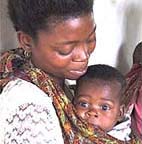|
April 20, 2001
Dear Colleague,
I am writing to you on behalf
of the Global Alliance for Vaccines and Immunization’s
(GAVI) Financing Task Force to request your input and comments
on the attached draft paper entitled, Financial Sustainability
of Childhood Immunization: Issues and Options.
Narrowly, this paper is intended
to contribute to the development and preparation of financial
sustainability plans required of countries applying to GAVI/The
Vaccine Fund. Countries that receive funds for new vaccines or infrastructure
development through the GAVI/The Vaccine Fund are expected to provide
financial sustainability plans to the GAVI Board 2 years from
the time of initial disbursement. These plans, which are to
be signed off by the Ministry of Finance, will detail the
long-term financial sustainability of the country’s immunization
program when initial support from The Vaccine Fund ceases.
More broadly, this paper seeks
to help donors and countries think about specific actions
that can contribute to – or conflict with – a long-term
goal of stable and adequate financing for childhood immunization.
Historically, discussions of financial
sustainability have been characterized by considerable debate
and divergence of opinion over definition and possible indicators.
This paper departs from the traditional ‘self-sufficiency’
definition and suggests that GAVI may wish to consider financial
sustainability to be ‘the ability of a country to mobilize
and allocate sufficient financial resources on a reliable
basis to achieve target levels of immunization performance,’
Through the attached paper, the
GAVI Financing Task Force is seeking broad input from knowledgeable
individuals and institutions about the characteristics of
financially sustainable programs, and the appropriate indicators
with which to measure progress toward financial sustainability.
In the first sections of the paper,
the authors propose a set of eight dimensions of financial
sustainability – encompassing both the efficiency of the
supply chain and the stability of the funding structure – and
identify promising actions that governments and donors can
take to promote sustainability. In Section VI, the authors
identify criteria for selecting useful indicators of financial
sustainability, and list possible indicators.
This paper is intended to provide
a framework for discussion, rather than to provide all the
“answers.” In particular, the assessment of which
indicators of financial sustainability are most appropriate
is a task to be done in a participatory fashion, taking advantage
of real-world knowledge about the availability of data and
other factors across many countries. Table 1 in the paper
is explicitly set up to invite such contributions: Reviewers
are asked to use the table to show how well the various indicators
stack up against the criteria. Contributions from a variety
of reviewers will greatly assist the Task Force in its job
of creating requirements for the financial sustainability
plans that will best serve the larger objective of more effective
immunization systems.
We would be grateful if you could
please direct your comments to Ruth Levine (rlevine1@worldbank.org)
with a copy to me (vmitchell@pacificcoast.net)
by May 31, 2001. Alternatively, you may fax or mail your comments
to:
Ruth Levine
The World Bank
1818 H Street, NW
Washington, D.C. 20433
Fax: 202.522-3135
Yours sincerely,
Violaine Mitchell
Coordinator,
GAVI Financing Task Force
 |
This document is also available
as a PDF document (approx.
361kb) |
Executive Summary
|

